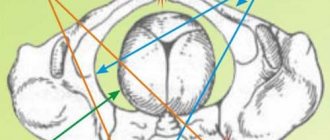The body after childbirth - what happens?
Immediately after the birth of a child, the placenta is rejected, and this is one of the stages of childbirth that causes damage to blood vessels, followed by the onset of bleeding. And this is considered the norm, but this is not menstruation, but a slightly different process.
Menstruation is periodic bleeding that occurs in the absence of pregnancy due to the rejection of the endometrium, which is formed for the attachment and development of the fertilized egg. In other words, if fertilization does not occur, then menstruation begins, which lasts from 3 to 5 days.
Bloody discharge after childbirth is called lochia - this is a kind of “cleansing” of the body from particles of membranes, mucus and other “residues”, and the duration of this process normally lasts about 40 days. Rejection of the placenta during childbirth gives a signal for a new hormonal change - the production of two important hormones in the female body - prolactin and oxytocin.
Prolactin is secreted by the pituitary gland and promotes the production of milk, which is necessary for feeding the baby, and at the same time it blocks menstruation (protecting the woman’s body from the ripening of new eggs and the onset of a new pregnancy while nursing a newborn).
This “forced pause” of missing periods is called postpartum amenorrhea, and how long it lasts depends on several factors:
- on the individual characteristics of the woman’s body;
- from the process of feeding the baby.
It is the process of breastfeeding a baby that stimulates the production of prolactin. As soon as the baby is put to the breast less often than once every 3 hours (and at night the interval will be longer than 6 hours), the level of the hormone will begin to decrease, and after some time, periods will resume again.
Operation stages
Like any complex operation, a caesarean section consists of several stages, the sequence of which doctors must strictly follow:
- Abdominal wall incision.
- An incision in the uterus.
- Carefully remove the baby.
- Applying sutures to the uterus and abdominal wall.
Each stage is important in its own way and requires increased attention from doctors. But the most important for the well-being of the woman in labor and the most important for further reproductive function is the latter.
The course and duration of scar healing and the restoration of the female body depend on how doctors behave and how competent they are. For most women, this process is limited to two to three months. Moreover, it is necessary to take into account the fact that the suture on the peritoneum heals much faster than the uterine scar. Therefore, if you are planning to conceive your next baby soon, do not be lazy to examine the scar using ultrasound.
The safest distance between births by cesarean section with a new pregnancy is 2-3 years. This period is quite enough for the scar to heal, all wounds and abrasions on the surface and inside the uterus to heal, and the body to recover and begin to function normally. If the pregnancy turns out to be early, it may be accompanied by unpleasant symptoms (such as pain in the scar area) and complications (violation of the integrity of the suture, its rupture).
How do you get your period back after childbirth?
The onset of menstruation after childbirth directly depends on the frequency of feeding the baby and on the characteristics of the woman’s body. Even in the same woman, with different infant feeding regimens, menstruation can resume according to different “scenarios”:
- In the absence of breastfeeding (if for some reason the woman does not breastfeed the baby), menstruation can resume 8-10 weeks after birth, that is, after the lochia (postpartum discharge) stops.
- Menstruation resumes 30 days after birth. A similar phenomenon during breastfeeding occurs very rarely, but is still possible, since during the period of postpartum discharge (lochia), which lasts from 20 to 40 days, the growth of the endometrium cannot occur, and therefore there will be nothing to be rejected after 30 days. However, medicine knows of cases where, instead of decreasing discharge by the end of the specified period, lochia, on the contrary, intensifies, which is perceived by women as the beginning of menstruation. However, the reason for this lies in a completely different matter: blood clots that appear in the uterus cannot come out, thereby provoking the onset of an inflammatory process and heavy bleeding, which can be stopped with a properly selected correction, and most often in such cases, curettage is performed.
Childbirth is always stressful for the female body. But several weeks and months pass, and the young mother’s body begins to gradually adapt to new conditions. Lactation is improved, a fundamentally new way of life is built. And the new mother wonders: when does her period begin after giving birth while breastfeeding? After all, menstruation is a constant companion for women of childbearing age.
Planning pregnancy: why not right away
With surgical intervention in the natural process of childbirth, which is associated only with the characteristics of this particular pregnancy, doctors do not prohibit giving birth in the future. They only recommend using contraceptives in the next few years, since early pregnancy can lead to complications.
This may be a rupture of the uterine wall due to insufficient healing of the scar. There is also a risk of placental abruption; it may simply be unprepared for the load. A caesarean section operation is a huge stress for a woman’s body; it may not be ready for a new pregnancy; there may simply not be enough strength and necessary resources to carry a baby.
In cases of early pregnancy after cesarean section, it is recommended to terminate it in the early stages; this can be done with medication. Of course, it happens that early pregnancy ends well for both the child and the mother. This is often the exception rather than the rule, so you need to think about the consequences in advance.
Lactational amenorrhea
Childbirth is always accompanied by the process of placenta rejection. This is a very “bloody” matter because it causes damage to the capillaries. Bleeding after separation of the placenta can last a whole month or even a month and a half. Such discharge is called lochi. The menstrual cycle has nothing to do with it, this is a phenomenon of a completely different order. How long does it take for full periods to begin?
In the very first moments after the birth of a child, the female body begins to produce prolactin. The main role in the production of the hormone is played by the pituitary gland, a part of the brain. It is prolactin that is responsible for the production of the baby's first food - breast milk. And it also inhibits the onset of menstruation (blocks the maturation of follicles during lactation). This period of rest of the female reproductive system is called postpartum amenorrhea or lactational amenorrhea. This phenomenon is observed in all women who breastfeed their babies not on time, but on demand. How long amenorrhea will last depends on several factors:
- characteristics of a particular woman;
- duration and frequency of the process of feeding the child.
It is breastfeeding that influences the pituitary gland so that it begins to produce prolactin. But it is this hormone that determines how long after childbirth menstruation begins during guards. If the mother begins to put the baby to the breast less than 7-8 times a day, prolactin levels begin to decrease. Consequently, the onset of menstruation becomes more and more likely.
When does your period start?
Periods after childbirth while breastfeeding - when do they start? It all depends on the intricacies of the hormonal system of a particular woman. And also on the characteristics of breastfeeding, which she practices. Does the mother feed often (when the baby wants) or rarely (according to a schedule)? Does the baby give water? Does he supplement with formula? All these points affect the timing of the first menstruation.
So when do “they” start? Here are the options:
A month after giving birth. Sometimes lochia, instead of stopping, begins to be released with greater force by the end of the 30th day. This phenomenon is often mistaken by women for early menstruation. Such cases are very rare, but nevertheless occur in medical practice.
"Spotting" during menstruation
Question. (Rita) After giving birth, my cycle noticeably shortened, instead of 28 days, now it’s 25, and it starts in two stages, on the 25th day there’s a spot, then 2 days of nothing at all, and then normal periods begin... What could be the reason? Answer . There can be many reasons for such a “daub” (endometriosis, inflammation, polyp, etc.). Without an examination, it is impossible to talk about any specific reason. The sooner you dare to go to the gynecologist, the better.
Question. (Cobweb) I have a question. I had an appointment with a gynecologist, I have an IUD. I didn’t go for a year, it so happened that after 2 days something was not comfortable, so I put on suppositories with ichthyol on the doctor’s advice. The next day, my lower abdomen ached and there was spotting, but not ichthyol! After 2 days, the daubing stopped. We were breastfeeding and didn’t have periods after giving birth. Before pregnancy, my periods were 5-7 days, very heavy. What could it be? Answer . Unfortunately, you do not indicate how much time has passed since the birth. Perhaps it was a menstrual-like reaction. Believe me, without an examination it is very difficult for me to answer such questions.
Question. (Travelmate) I gave birth three weeks ago. The lochia is not over yet, the last week of pink discharge, about 2 tablespoons per day. Yesterday, when I abruptly got up from the sofa, slight bleeding appeared (about a spoonful of blood), a blood clot came out, and my stomach hurt, like during menstruation. Today the lochia is pink again, my stomach does not hurt. What could it be? Do you need to see a doctor urgently? I planned to go only in a week. Answer . The bleeding could come from the cervix or from the vagina if there were ruptures during childbirth, after lifting weight or straining during the act of defecation. In case of recurrent bleeding, you must see a doctor urgently, but if everything goes well, visit the gynecologist in a week as planned.
How menstruation affects lactation
During menstruation, some mothers may feel that their milk supply has decreased slightly. The baby at the mother's breast sometimes becomes nervous because the milk flows slower than usual. Fortunately, this decline does not last long - literally the first 2-3 days after the start of the first menstruation after childbirth.
Subsequently, the amount of milk returns to normal and lactation improves. For most children, however, such changes may go completely unnoticed. As a rule, at the beginning of the first menstruation, the child is old enough and is on complementary foods. This compensates the baby for some lack of breast milk.
Some experts are inclined to believe that menstruation indirectly affects the taste of mother's milk, which is the reason for the child's refusal to breastfeed. However, there is no confirmed data on this - according to most doctors, menstruation does not in any way affect the taste and smell of breast milk. Consequently, the reason for the baby’s anxiety at the mother’s breast is not at all connected with the onset of menstruation, but is caused by other reasons.
The first periods during guarding - what are they like?
The first periods after childbirth during breastfeeding can be anything - heavy or weak, prolonged or two days. This is all normal. You should be wary only if the discharge is too heavy, reminiscent of uterine bleeding, or if the delay lasts longer than three weeks.
The length of the cycle for guards is also not immediately established. Setting up your menstrual cycle is a purely individual matter. Usually the cycle returns to normal within 3-4 months after the end of lactation. But if a nursing mother had an irregular cycle before pregnancy, she may encounter similar problems after breastfeeding ends. The peculiarities of the birth process (natural delivery or by caesarean section) do not play a role in the situation of establishing menstruation.
Many girls pay attention to the fact that menstruation during breastfeeding has become less painful than before - the stomach no longer aches, and the general state of health has changed. Perhaps the reason is that the uterus, which was bent before pregnancy, returned to its normal position after childbirth. Also, some mothers notice that the menstrual cycle has become somewhat shorter than usual.
A little history
For several centuries, the concept of “early pregnancy” did not exist at all. Because a girl was considered capable of conceiving and giving birth to a child as soon as she had her first menstruation.
Therefore, girls were married off at the age of 13-14, and at the age of 15-16, most of them already became mothers. This trend was due to high mortality among children and adults. And, according to society, for the survival of the family, a woman had to begin fulfilling “her mission” as early as possible.
Therefore, in Rus' and Europe, a girl who did not get married and did not give birth to at least one child before the age of 18 was considered “overage.” And over 20 years old - a hopeless old maid, who could only be interested in an “old” widower of 40 years old with a large family.
In addition, in those years, early childbirth was biologically justified. The fact is that women suffered from anemia due to monthly bleeding, which no one corrected. Unfortunately, it progressed with age. And anemia, as we know, reduces the ability to carry a normal pregnancy and give birth to a healthy child.
When to see a doctor
And although the onset of menstruation is a very individual process, in some cases you will have to see a gynecologist:
- When the mother refused to breastfeed, and her period did not start 4 months after giving birth. This situation may be caused by problems of the genitourinary system.
- If you have stopped breastfeeding, but still haven’t had your period. Wait a couple of months and go to the doctor. This may indicate endometriosis, inflammation of the female part, or (most often) hormonal imbalances in the body.
- Menstruation during lactation is unusually heavy, you have to wear a “night” pad during the day, and even supplement it with a tampon.
- Bloody discharge has an unpleasant odor. This may signal a genitourinary tract infection.
- I am worried about unusual severe pain in the lower abdomen. In such a situation, you should always immediately go to the gynecologist, and it does not matter whether this happened during gw or not.
Many mothers believe that it is impossible to get pregnant during lactation because the eggs do not mature in the body. Reassured by this fact, young mothers do not consider it necessary to use additional contraception. However, it has been scientifically proven (and confirmed by practice) that pregnancy during breastfeeding in the absence of menstruation is quite possible. Proof of this is many cases, as a result of which children of the same age appeared in the family.
My period has started - is my milk leaving?
If menstruation begins while breastfeeding, this does not mean at all that there will be no more milk and it’s time to switch the baby to formula. The amount of breast milk depends little on menstruation. Consequently, a mother can feed her baby until she deems it necessary to stop breastfeeding or until the milk disappears spontaneously. The menstrual cycle has nothing to do with this process.
Menstruation signals that the reproductive system is in order. The presence of discharge indicates a woman’s ability to have children; it is by this discharge that girls predict many processes in the body (for example, the onset of ovulation). At the same time, it is useless to guess when the first menstruation should begin after childbirth. A young mother should relax and enjoy the process of breastfeeding. Nature will take care of the rest of the physiological processes of the female body.
During pregnancy, a woman gets used to the fact that there are no periods in her life. With the birth of the baby, the new mother, having heard and read a lot about the restoration processes in the body after childbirth, begins to wait for the resumption of the monthly cycle. And often the absence of menstruation, due to increased emotionality, is considered pathological and one begins to feel nervous, which, of course, negatively affects both the woman herself and her child. Therefore, this physiological aspect of returning to the pre-pregnancy state requires detailed consideration.
Causes of accelerated and delayed involution
While waiting for the restoration of a regular menstrual cycle, a woman after childbirth should take into account factors influencing this process:
- Too weakened body after childbirth.
- Multiple pregnancies (third or more).
- The first birth for a woman over 30 years old.
- The pregnancy proceeded with complications.
- Labor was difficult, with deviations and pathologies.
- Poor diet of a young mother
- Postpartum depression or moral fatigue, apathy.
The female body after childbirth
Childbirth is stressful for a woman’s health, and recovery takes time.
The resumption of menstruation is an important indicator of recovery after childbirth
What is lochia
The female genital organ after the birth of a baby naturally or through cesarean section is a wound surface formed after the rupture of many vessels connecting the baby's place with the body of the uterus. Like ordinary mechanical tissue damage, such an injury bleeds for some time during the healing process. In addition, while carrying a child, the uterus stretches, and after childbirth, thanks to the action of the hormone oxytocin, which is responsible for contraction of the uterus, it begins to restore its previous size, rejecting some of the fibers, which is also accompanied by bloody discharge from the vagina. All this leads to the fact that up to 40 days after the birth of the baby, a woman observes discharge of varying degrees of intensity with lumps - lochia, which gradually fades away.
Possible complications of second birth
- Weakness of labor in the second stage of labor (during pushing) may be associated with a weakening of the tone of the anterior abdominal wall.
- Bleeding in the postpartum period (this complication occurs more often in multiparous women than in primiparous women). A decrease in uterine contractility is also facilitated by the presence of a scar on the uterus, a planned repeat cesarean section, and inflammatory diseases of the uterus after a previous birth.
Everything that has been said about the possible complications of a second pregnancy that occurs immediately after the first birth is intended to make a woman think about her health and pay as much attention to herself as possible. But all these difficulties are not a reason to terminate the pregnancy, since abortion is fraught with much more serious complications for the female body.
Menstruation during lactation
It would be logical to assume that while a woman is lactating, that is, a lot of prolactin is secreted, menstruation does not occur. However, the recovery of the cycle is greatly influenced by factors such as:
- heredity (there will certainly be a difference between the periods of restoration of the menstrual cycle of different generations of women of the same family, but not too much);
- the presence of pathologies (if inflammation and infections are detected in a young mother, then it is very difficult to predict the timing of the restoration of the menstrual cycle);
- type and duration of breastfeeding period.
The resumption of the monthly cycle is determined, among other things, by the characteristics of a woman’s lactation
Timing of menstruation during lactation
Even more interesting:
Ulcer on the head in men photo
Tongue with rubella in children
It is the last factor, associated with the characteristics of the feeding regime, that in most cases has a strong influence on the resumption of regulation. To begin with, it is worth paying attention to this dependence: prolactin is produced in large quantities when the baby does not receive additional food and drink. Accordingly, when complementary feeding and supplementation appear in the baby’s diet, less prolactin is produced, which means a gradual restoration of the balance of hormones responsible for ovulation begins.
Average norms
In the last few years, pediatricians have recommended introducing complementary feeding and supplementary feeding after 4–6 months, so these dates have become guidelines for the starting point for the resumption of menstruation. It is worth noting that even after complementary feeding has been introduced, with partial breastfeeding, menstruation may not come. Breastfeeding specialists, in addition to hereditary factors and the presence of pathologies, include the practice of feeding at night and early in the morning as the reasons for such a delay. The fact is that more prolactin is produced at night, and this allows you to maintain its content in the body at a high level.
This is interesting. If a woman practices a combination of breastfeeding and bottle-feeding, her period comes on average 3-12 months after birth. Such a large difference in timing is associated with the peculiarities of reducing the number of feedings: if the baby stops breastfeeding at night and in the morning, then menstruation will come sooner.
Restoring the monthly cycle after childbirth can take a long time
Table: variants of the norm and deviation in the timing of the resumption of menstruation after childbirth
| Deadlines | Normal or deviation | When is this possible? |
| in a month (30 days) | Deviation | The growth of the endometrium, which is shed during menstruation, occurs gradually. 30 days after birth, when the lochia has just ended, this is impossible. But increased postpartum discharge due to a clot that provokes inflammation is the most likely cause of heavy bleeding similar to menstruation. In such a situation, you should immediately contact a gynecologist. The woman may be prescribed curettage to remove the clot. |
| in 3–4 months (90–120 days) | Norm | Such timing is determined by the individual characteristics of the body, as well as the transition to mixed feeding or refusal of lactation. Doctors define this situation as the good functioning of the pituitary gland in a woman. |
| in a year | Norm | The child switches to an “adult” diet, the number of feedings, including night feedings, is reduced - lactation decreases, the cycle is restored. |
My period started exactly a year after I gave birth)))) It’s normal, it doesn’t come much. I don’t even feel pain (beauty!)))
Valentinka
https://deti.mail.ru/forum/nashi_deti/kormim_grudju/mesjachnye_pri_gv_by_sama_n_mail_ru/
I started having them exactly 6 months later, and immediately regularly every month, just like before pregnancy. And she fed until she was 1 year 4 months old.
https://sovet.kidstaff.com.ua/question-18605
This is interesting. Restoring the monthly cycle after a cesarean section occurs in the same way as after a natural birth. If a woman has experienced an abortion or miscarriage, the resumption of menstruation is determined by the presence or absence of complications after the curettage procedure.
Fourth month after birth. Mother and child.
Four months flew by in a flash. It was a time of tremendous physiological and psycho-emotional changes. Your baby is no longer bothered by colic. The gastrointestinal tract works like clockwork. The baby is becoming more and more familiar with the world around him. Knowledge for him became the main purpose of existence.
Four month old baby. Physiological aspects of development
Height and weight parameters
There is not yet enough active movement at this age, which is reflected in weight gain in children (about 750 g in total). The baby weighs from six to seven kilograms, and his height has reached sixty centimeters.
Reflection
We notice the fading of the newborn’s reflexes and the emergence of new ones, more adapted to contact with the outside world:
- Robinson's grasp reflex becomes more focused. The baby is interested in the objects around him. He pulls them towards him to look at. This is how fine motor skills develop.
- The Moro reflex no longer appears or is at the leveling stage.
- The crawling reflex with the condition of creating support for the legs disappears. With artificial stimulation, the baby can quickly be taught to crawl independently.
- The Talent reflex is leveled when the child's back bends when exposed to the spine and the similar Perez reflex.
Note. If something worries you, consult a doctor to prevent the formation of possible neurological disorders.
What can a child do?
We list the skills required for a child at this age:
- Rolling to the sides and onto the back.
- Lifting on the handles with support on the palms and holding the head.
- Ability to sit down when pulled by handles. Do this procedure carefully - the baby’s back is not yet strong.
- Pushing away from the floor while leaning on it.
- Playing with palms, folding them, clapping on objects.
- Holding toys for a short time, shaking the rattle to produce sound.
- Purposeful thumb sucking.
- Supporting the mother's breast during sucking.
Problems of psycho-emotional development
The baby reacts violently to people's voices, especially actively rejoices at his mother, moving his arms and legs, smiling and babbling something.
You can already recognize some consonant and vowel sounds. The baby’s reaction to new toys manifests itself in a similar way. At this age, children begin to learn their name.
The ability to trace cause-and-effect relationships develops. For example, the baby already understands that the breast is a source of food. When he sees her, he becomes silent and prepares to suck.
Senses available to a child at four months:
- fear;
- joy;
- resentment;
- interest.
The baby spends a long time studying his body, plays with his arms and legs, touches his head, hair, ears, nose, and loves to look at himself in the mirror. He gets to know people and treats them based on his priorities. He worries and rejoices with his mother. He is very wary of changes in the appearance of loved ones. She may burst into tears if her mother puts an unfamiliar scarf on her head or pulls her glasses up her nose, because she no longer recognizes her. The baby is afraid of strangers and animals.
The child actively develops visual and auditory perception, knows how to follow moving objects, and recognizes familiar toys.
Vision development
The baby learns:
- Perceive color, giving preference first to yellow and red, and then to green and blue shades.
- Pay attention, first of all, to bright colors. He doesn’t understand multi-color compositions yet.
- To perceive toys that are oversaturated with colors, which quickly tire him.
Hearing development
The child reacts to sounds by turning his head. He looks for the source of irritation with his eyes. The baby can already distinguish the voices of his family and friends well. He loves music very much, preferring cheerful and calm rhythms, with which he already shakes his head to the beat. Sharp, high-pitched and unexpected sounds from the baby are annoying.
Important! During this time, you definitely need to talk a lot with your child. Do this in the form of comments on your actions. Show him pictures and describe in words what is shown there. This practice is very useful in terms of quickly and effectively learning spoken language.
Diet and sleep problem
It is best to feed your baby on demand. The criterion for you should be the average rate of weight gain. If there are no problems in this regard, there is no point in counting the number of feedings.
We remind you that mother’s milk or modern formulas contain all the substances necessary for the baby, so feeding this way for up to six months is absolutely sufficient. Until this time, it is best not to use additional nutrition.
At four months, a baby needs an average of 15 hours of sleep. During the daytime there are about three hours. During the night, your baby may wake up to feed one to three times, which is considered normal.
Put your child to bed no later than 21:00, as at this time he becomes significantly tired and may be moody at night. Teach him to a clear and consistent sleep and wakefulness pattern during the day and night.
Baby and the healing power of a mother's voice
The development of the child at this time is most closely connected with his mother. Carry your baby in your arms everywhere or carry him in a stroller, while maintaining a constant dialogue with him.
Childhood diseases. What to do if the child feels unwell?
Boris Drapkin's technique
There is no better medicine for a baby than his mother. No pills or injections have such a powerful effect on his well-being as the voice of a loved one. With the help of his mother, the child will cope with any difficulties and illnesses.
It was the connection between babies and their mothers that the child psychiatrist, Professor Boris Zinovievich Drapkin paid attention to when creating a unique psychotherapeutic method for treating childhood pathologies, calling it “mother therapy.”
This medical technique has gained success in our country due to its high efficiency, simplicity and safety. It was approved by the All-Russian Society of Child Psychiatrists and the Ministry of Health.
Brief description of Dr. Drapkin's method
Very little time passed after the baby was born. The connection between him and his mother is maintained at a very high emotional level. There is an explanation for this - biologically, such relationships were established during the period of gestation, and are now strengthened during breastfeeding.
The child perceives the mother's voice as his own, internal. Therefore, the psychotherapeutic power of this voice cannot be described. At this time, the baby, like air, needs peace, care, love and a sense of security. If these feelings are constantly conveyed by the voice of his mother, the child receives a healing effect of the natural order.
In other words, children formulate requests and if there is an adequate response to them, then they receive psychological protection. Mothers become healers against their will, in the most natural way.
Mom is a relay of love
It is very important for a child to receive constant confirmation of his importance from his mother. Let's call these “love signals.” The mother’s feelings are a certain emotional wave that the child tunes into. The psychological factor can be used to create positive perceptions and natural healing through several actions:
- Physical block.
- Neuropsychological block.
- Traditional medicine block.
- Signal of love.
This is the internal work of a mother with her baby, invisible to prying eyes, the use of community with her son or daughter for the purely pragmatic goal of healing. The child, being psychologically highly dependent, feels this mood. He thus saves his strength, as he receives confirmation of his request for protection and love.
Note. This technique is useful in any case, regardless of the specific condition of the baby. It is based on the use of specially selected phrases with a positive meaning. The child is instilled with a model of a certain model of attitude and behavior in a state of sleep.
Mom therapy in practice
It is necessary, after the child has been sleeping for twenty to thirty minutes, to go to his crib and make sure that his sleep is calm and sound. Then you should put your hand on his handle or head and say mentally, then out loud, certain phrases with a positive psycho-emotional load.
Here it is important not to rush, but to use inner conviction in what you say. These are certain waves of love, care, a mood of peace and confidence that everything will be fine.
The power of the technique lies in repetition and reinforcement. On average, the entire program should last about two months, and you will notice its healing effects within a few weeks.
In fact, there is nothing new in this technique, except that it is used on children through the suggestion of their mothers. In this case, we can talk about the connection between the method of psychotherapist Drapkin and the use of healing mantras in India and China.
Here it is just as important to use strictly and uniformly formulated expressions, always positive, without rearrangements or additions. The effectiveness of this technique has already been scientifically and statistically confirmed on hundreds and thousands of children.
There is a general program and its subtypes, individually prescribed during use by psychotherapists. It is necessary to begin and end each session of such maternal therapy with a powerful message of love. The program has an affirmative and motivating meaning, in which the negation “not” is not used. The mother promotes the natural and unformulated desire of the baby to realize the positive qualities of a full life in happiness, health and creativity.
Let us give examples of psychological blocks developed by Professor Drapkin.
Mother's love
- I love you so much, so much.
- You are the most beloved dear baby in the world.
- You are a part of me, my dear little one.
- I live for you.
- Me and your dad love you.
Physical health mindset
Use your child's mental ideal:
- You are my strongest, most harmonious and healthy boy (girl) in the world.
- You have an excellent appetite, you are growing well and developing well.
- Your heart works like a clock, it is strong and healthy. Your chest and tummy are always healthy and happy to do their best for you.
- Your movements are light and beautiful.
- You are always healthy, you are seasoned and joyful.
Strengthening neuro-mental health
- You are always calm. Your nerves are strong and very good. You are cheerful and benevolent.
- You are patient, kind and sociable.
- You're smart (you're smart). Your head is developing beautifully. You understand everything, you remember everything wonderfully.
- Your mood is always good, you are always smiling.
- You sleep well. You fall asleep very easily, quickly. You always have very joyful and kind dreams. You always gain enough strength during sleep.
- You learn words quickly and well. Your speech is developing well.
- You can see all the colors. You see everything perfectly. Your eyes work wonderfully.
The emotional aspect of the impact, a method of cleansing from diseases
- I separate your illness from you, I throw your difficulties, pain and (specific in this case) illnesses far from you.
- I separate from you and throw far, far away the cause of your bad sleep.
- I take your bad dreams and throw them away.
- I take away your cry. I throw it out of your sight.
- I take your bad appetite, throw it away, give you a new wonderful appetite.
- I love you so much.
A woman four months after giving birth. What hurts?
At this time, mothers who have undergone childbirth may be bothered by stitches from ruptures or scars from surgery.
Remember that pain is also possible in the back area. This is not surprising, because you often carry a child in your arms. The load on the chest also makes itself felt.
What to do?
Do strengthening types of gymnastics daily. Pay attention to special exercises for the back muscles. Book a gym membership. Try not to make sudden movements, but focus your efforts on supporting the muscle frame.
Follow the simple rules of spiritual harmony, think only positively, enjoy life.
Be happy. Give love to your child.
Child 3 months development. Mother and child.
Fifth month after birth. Mother and child.
Date published: 2016-04-11 Last modified: 2020-01-16
First menstruation: symptoms, discharge and duration
During pregnancy and lactation, a woman loses the habit of the “menstrual” state. And since it is impossible to predict the exact dates of the start of menstruation, most new mothers fear that their periods will begin unexpectedly. Meanwhile, in most cases, it will not be difficult to guess the symptoms of the onset of regulation, since the following will appear:
- pulling pain in the lower abdomen;
- sudden mood changes;
- recurrent headaches.
It’s worth preparing yourself in advance for the fact that perhaps the nature of the discharge will be different:
- more abundant or, conversely, less abundant than in the pre-pregnancy period;
- accompanied by more intense pain;
- with lumps (as a rule, this feature is inherent in the case if menstruation began shortly after the end of lochia, which means that the endometrium is still in the recovery stage).
The duration of the first menstruation after childbirth may differ from usual in the direction of increasing or decreasing the period. On average, in the absence of deviations, menstruation lasts 7–8 days, and the timing varies between 21–30 days. Gradually these indicators will return to normal.
How periods affect breast milk
Not at all when it comes to quality indicators. Therefore, the conviction of some women that after the resumption of regulation, the child must be weaned from the breast, has no basis. Moreover, it is harmful to the health of the baby, for whom breast milk is the key to strong immunity and proper development. The only possible consequence of the onset of menstruation that affects the characteristics of milk is a decrease in its quantity. The remaining changes concern, to a greater extent, the “relationship” between the breast and the baby:
- the sensitivity of the nipples increases, the baby’s touch can be painful (breastfeeding specialists recommend applying a warm napkin to the nipples before giving the baby the breast, and if the pain is unbearable, express milk during menstruation and feed the baby from a bottle);
- increased activity of the sweat glands during menstruation may cause the baby to not like this change in smell (therefore, the importance of hygiene procedures increases even more).
2 days before my period, my milk actually dropped sharply, then, when it ran out, it came again with greater force, so 5 days in total, my daughter was capricious at that time, she sucked and threw the breast, cried, she didn’t have enough, apparently. then everything is fine. We experienced such moments.
KARSULYA
https://38mama.ru/forum/index.php?topic=216035.0
If the baby hurts when sucking, then during menstruation he can be bottle-fed with expressed milk
Menstrual cycle disorders
Some differences in the course of 2–3 month cycles after childbirth from those to which a woman is accustomed (slightly more painful, longer, etc.) are not pathology. Although, if you have any concerns, it is still better to consult a gynecologist.
This is interesting. If there is heavy bleeding and unbearable pain, there can be no other options: the woman definitely needs urgent help.
There are also a number of violations that indicate pathological conditions and require specialist consultation.
Heavy and prolonged menstruation
Long periods include periods that last longer than 8 days. As a rule, they are characterized by copious discharge. You can determine the intensity of the discharge at home: if one pad lasts for 2.5–3 hours, the bleeding is considered intense. Typically, women who have had a caesarean section face this problem. In any case, long and heavy menstruation may be evidence that:
- the particles of the membranes did not completely come out during the lochia process;
- inflammation develops in the genitals;
- the woman is or has been in a stressful situation;
- The young mother had anemia while pregnant.
After diagnostic procedures and a history study, the woman is prescribed either conservative treatment (medicines that stop blood loss, vitamins, and iron-containing drugs), or, if there is no improvement, curettage to stop blood loss and exclude the possibility of tumor development in the endometrium.
My first periods were the same and lasted longer than usual. The doctor said that it was normal, the body was adjusting to a new rhythm.
Erase the PAST
https://deti.mail.ru/forum/nashi_deti/kormim_grudju/mesjachnye_pri_gv_by_sama_n_mail_ru/
Long periods are usually accompanied by heavy discharge
Accelerated menstruation
Typically this disorder is caused by:
- strong and sudden weight loss of a young mother;
- large blood loss during childbirth;
- a strong increase in prolactin - hyperprolactinemia.
Meager regulations
Spotting for more than three cycles in the absence of hormonal contraception can be caused by:
- imbalance of hormones;
- endometritis, that is, inflammation of the mucous surface of the uterus;
- Sheehan's syndrome (a neuroendocrine disorder caused by the death of some pituitary cells due to complications during childbirth).
This is interesting. Since even in the absence of menstruation, after the completion of postpartum discharge, a woman can become pregnant, the choice of a method of contraception should not be postponed. However, we must not forget that when an intrauterine device is installed, periods may become more intense and painful, and when taking birth control pills, on the contrary, they may become more scanty.
Scanty periods are common if a woman takes birth control pills
Unstable cycle
Such a violation (including a break of more than three months) can be diagnosed no earlier than six months from the date of resumption of the cycle. Deviation may be caused by:
- pathological processes occurring in the ovaries;
- exhaustion of the body;
- complications during childbirth (the consequences of epidural anesthesia also include this);
- development of neoplasms in the pelvic organs;
- deviations in the functioning of the endocrine system.
If menstruation occurs twice a month for more than three cycles, then there may be a malfunction of the pituitary gland.
The cessation of menstruation after 1–2 cycles requires, firstly, the exclusion of a new pregnancy, and secondly, consultation with a specialist regarding the possible onset of early menopause. Despite the fact that this is a rather rare occurrence, the possibility cannot be completely rejected.
I started at 8 months. That is, no. Either 2 days or 2 weeks. I didn’t even notice how I got pregnant!!
Anonymous
https://sovet.kidstaff.com.ua/question-18605
Many new mothers face the problem of unstable cycles.
Itching, uncharacteristic odor and color
Itching and curdled discharge are characteristic signs of thrush, and a pungent odor, scarlet color and accompanying chills with unbearable pain in the lower abdomen require urgent diagnosis, as they may be symptoms of serious infections or cancer.
Video: cycle disruption during breastfeeding - expert explanation
Second pregnancy after cesarean. And just 10 months later
Early pregnancy after cesarean section is what doctors primarily scare women after surgery. “When can you get pregnant after a CS?” - I asked too. “In 2-3 years,” the doctor answered. But fate decreed otherwise.
My first pregnancy was unexpected and unplanned, but, nevertheless, the baby was very desired. True, they prepared the wedding in the shortest possible time and got used to the new realities.
The pregnancy proceeded calmly, without any complications. But until the sixth month I suffered from terrible toxicosis, I even fainted several times and got bumps on my forehead. She did not leave the house on her own, even to the nearest stall to buy bread. As it was, all the tests were normal, so I was going to give birth naturally, without worrying too much about it. Considering my body type (tall height and wide hips), no complications were expected; the attending physician even joked about this that the baby would fly out without even noticing. But exactly the opposite happened.
Weak labor, alas...
Two weeks before my due date, my water started to break. This lasted several hours, but since there was no pain or contractions, I was in no hurry to go to the maternity hospital. In order not to tempt fate, I still got ready in the evening. After the examination, the doctor said that I could sleep peacefully for another night. Until lunchtime the next day, the situation had not changed qualitatively, but since there was practically no water left, a decision was made to stimulate.
Ten hours of stimulation and terribly painful contractions brought virtually no results; the opening of the uterus was not expected. Therefore, the decision was made to have a caesarean section. I was already so exhausted that I agreed immediately. The anesthesiologist recommended local anesthesia. And within an hour I had a beautiful son, weighing 3100g, absolutely healthy.
For some reason, most women perceive a caesarean section as something very scary and extremely undesirable, but, in fact, it is just another way of bringing a child into the world. Yes, it is often unexpected and has its consequences, but natural childbirth does not always go smoothly.
There were no complications after the operation, but the rehabilitation period was quite difficult and difficult. It’s good that my mother was nearby all the time: she prepared food, bathed the child, and dressed/changed clothes for the first weeks.
And when, several months later, I finally returned to my normal lifestyle, the stitch no longer made itself felt, and there was a delay. At first, I somehow didn’t even attach any importance to this fact, since after childbirth anything can happen, but a few days later I bought a test and saw the terrifying two stripes. To say that it was unexpected is to say nothing. My husband and I were in a panic.
My early pregnancy after CS
Pregnancy after a caesarean section a year later - I read about this. But we've only had about 10 months! After all, everyone knows that after a cesarean section it is possible to give birth within two to three years. We immediately rushed to the doctor. Thank God, he reassured us and said that this was not an isolated case and women successfully give birth by caesarean section even at such a short period. But still, somewhere on a subconscious level, the fear remained that suddenly the seam would come apart or that I would not be able to bear the child.
The second pregnancy went well, there was no more toxicosis, but in the last months my back began to hurt very badly. The situation was aggravated by the fact that I had a one-year-old child in my arms. I contacted a neurologist, he prescribed pills for back pain, but did not recommend abusing them. For the last month, I only went outside once or twice a week, as it was very painful to walk and, in particular, to go down stairs. The husband left work and took care of his son.
When the time for caesarean section arrived, the doctors again recommended local anesthesia, although I was more inclined towards general anesthesia. The surgery went well, just like the first time, the boy was born healthy, the only caveat was that the skin was yellowish in color. They kept him under some special lamp for several days and everything went away.
So girls, know that two caesarean sections are not as scary as they might seem. The old stitch is cut off and a new one is made, so you won't have two scars.
The rehabilitation period after the CS was more difficult and lengthy; it even seemed to me that I would never get out of this state. It was very difficult to get up on my own, not to mention the fact that children were screaming on both sides. My head was pounding, and I didn’t have enough time for quality rest.
But now it's all over. I have two charming sons growing up and, although their harmfulness sometimes goes off scale, it is such happiness!
Ways to normalize the cycle
All questions regarding the restoration of the monthly cycle must be discussed in advance with a gynecologist. This is especially true in cases where there were complications during childbirth. A general list of recommendations regarding stabilization of the monthly cycle comes down to the following points:
- enriching the diet with vitamins and microelements;
- moderate feasible physical activity (usually doctors recommend Pilates, yoga, swimming);
- wearing comfortable underwear to prevent blood stagnation in the pelvic organs;
- prevention of emotional overload and stress;
- consuming a sufficient amount of liquid (this advice does not apply to those mothers who wean their babies from the breast - in this case, drinking a lot of liquid, on the contrary, is prohibited);
Liquid increases milk production
This is interesting. If a woman has postpartum depression, then she needs to take a course of natural sedatives, introduce herbal teas into her diet, and if there is no improvement, seek professional help from a psychologist.
During lactation, restoration of the monthly cycle has its own characteristics, which you need to know about in advance. This will help avoid health problems for both mother and baby. But in any case, if a woman still has any concerns or suspicions, then the surest way to resolve them is to consult a gynecologist. Only a specialist can conduct a competent diagnosis, prescribe the correct treatment, or simply dispel doubts and reassure.










